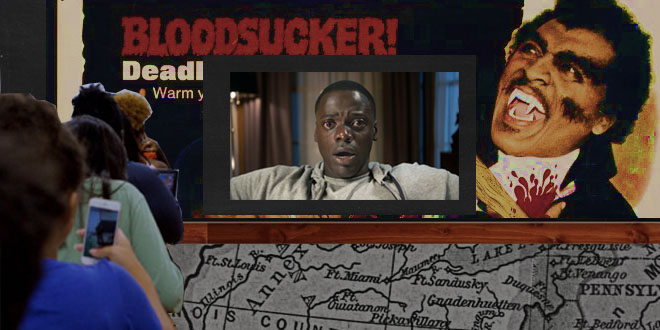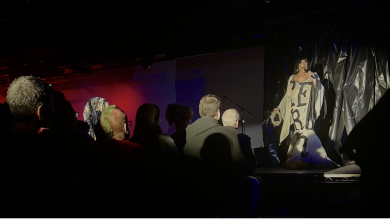How the “Get Out” Class Can be a Catalyst for Change at UCLA

Design by Isabella D’Agnenica
The colloquially named “Get Out” class was perhaps the most talked about and anticipated course for UCLA’s Fall 2017 Quarter. The African-American studies 188A: “The Sunken Place: Racism, Survival, and Black Horror Aesthetic” class was created by UCLA Professor Tananarive Due. It explores the Black horror aesthetic using films like “Get Out,” “Blacula,” and literature such as Due’s “The Good House.” The “Sunken Place” is a prime example of how new, fresh, and diverse classes are necessary in any school curriculum — while also highlighting the lack of such courses.
When Due saw “Get Out,” a movie ripe with themes covering race relations and the Black experience in the United States, she was inspired to create a class that looks back at historical representations of Black people as monstrous in films and literature, and the reclamation of the narrative since then. This includes the U.S.’s first blockbuster film, “Birth of a Nation,” which was White supremacist propaganda to fear Black people, especially in the context of Black men as a danger to White women. This film perpetuated a false narrative that is still ingrained in Hollywood and modern culture today.
Nimotalia Ganiyu, a fourth-year African-American studies student who is taking the class, described “The Sunken Place” as a “black horror class, where we basically analyze different characters and how it relates to present day… in forms of movies, books, and short stories and analyze black horror in those mediums.”
Ganiyu described the objective of the class as highlighting Black producers and directors who help showcase that there is a Black aesthetic to horror beyond the stereotypical Black person who is the first to die or to sacrifice themselves in the horror medium. Ganiyu added, “What we do is shine a light on the different roles a Black person can be in a horror film.”
Cierra Black, a third-year political science and African-American studies student, mentioned that “the purpose [of the class] was to analyze horror in a more substantial way… a lot of times people view horror purely as a way of entertainment, but the way Professor Due explained it was horror helps process our trauma in our lives… [especially when] looking at horror through the Black experience, because what is horrific to us, might not be horrific to other people, and vice versa.”
Horror can be anything that brings about an emotional response, especially if it is meant to frighten. Horror should not be seen simply through a black-or-white lens — that not only zombies, ax-wielding murderer’s, or scary clowns make up the horror genre. Films such as “Birth of a Nation,” while not typically classified as horror, can be experienced as such, since the intent behind the movie was White supremacists scaring the American society of the time.
The work of Jordan Peele, director and writer of “Get Out,” is a major example of how the reclamation of Black representation in horror, also brings about a unique aesthetic to the genre. Through “Get Out,” Peele emulated a space which showcased some of the anxieties and microaggressions that Black people may feel as an oppressed group in the U.S., while also creating an empathetic Black lead that helped deconstruct racism for (white) audiences.
“Controversial moments in Black film [are important], because a lot of it relates to reality, and a lot of the producers and directors want to bring out things we can discuss and analyze… It’s good that we have this class because we can pinpoint these specifics things,” said Ganiyu.
The Black horror aesthetic was explained as being based on the experience and trauma that can occur to Black people, and how it is processed. Experience can shape the way that art is interpreted and viewed. “The Sunken Place” really takes care to highlight how the way people of color appreciate art might not be considered the conventionally accepted way to view art. It is important to take into account everyone’s experience, as in the grand scheme of appreciating and creating art, the erasure of experiences is detrimental to both art as a whole, and to the different demographics that aren’t taken into consideration when art comes into play in day-to-day life.
“Things that have to do with paranormal activity… things that could be dangerous aren’t the first things we [Black people] would go out to do which might have something to do with the history of violence and trauma towards Black people, which is a big factor [the class] talked about… and how that plays into the aesthetic,” Black said.
In an interview with Gizmodo Due said, “Look: I love horror. But it never dawned on me that I could have a Black horror course before ‘Get Out.’ When a movie like that comes along, you now have a reference point to talk about everything that has come before.”
Due mentioned how now when she talks to network executives about potentially developing a pilot, they understand the narrative, when before there would only be awkward pitch scenarios. The irony lies in when the pitch is not similar to “Get Out,” it is simply used as the new framework. “Get Out” is just the tip of the iceberg of what Black horror could look like, which can now be used as “a reference point and you can continue with the conversation. Because before, you could barely even get the conversation started.”
Lack of representation in Hollywood is nothing new. The 2017 Hollywood Diversity Report, a study done at UCLA, showed that in the 2014-2015 broadcast season white actors — mostly men — account for three-quarters of the scripted roles. The minority share of lead roles peaked at 16.3 percent in 2013, compared to the 83.3 percent of White leads. Minorities also saw a decrease in film writing credits — 5.3 percentage — and film directing credits — 10.1 percent — compared to last years report.
The drop in writing and directing film credits is particularly disturbing, as often certain experiences can only be written to full fruition by those who fully understand them. Due commented, “It’s really interesting to watch the difference between how Black actors were used in horror movies made by White filmmakers, as opposed to what they do under their own power and direction.”
Representation in both behind-the-scene and on-screen media is incredibly important to tell the often unspoken stories of underrepresented groups. Due described horror as a great medium to express “social evil through the energies and emotions of fictional characters.” In terms of how horror can relate to the current U.S. mentality on race relations, Due framed horror as a way to address the violent history in the U.S., such as the slavery and genocide that have existed since it’s conception.
School curriculum similarly lacks in diversity. Part of the reason why “The Sunken Place” gained such attention and traction, aside from Peele’s surprise visit to the class on Oct. 12, is because there has never really been a class like this before, at UCLA or any other school.
Departments at UCLA have a large selection of courses to choose from, many of them are series which build off of previous topics. However, most of these courses tend to fall into similar categories — “The Sunken Place” is seen as a refreshing new course that takes on a new topic.
Ganiyu said it was important to have classes like this at UCLA because “as an African-American studies major we talk about a lot of the same things in different ways. I do learn a lot and you learn how to critically think, but I do think that sometimes our curriculum is oversaturated in the same things … of course Black people have struggled and we are institutionally oppressed in certain ways, but for me I would personally like to talk more about pop culture, and where we are now, and how we have risen from oppression.”
“The Sunken Place” shows that not only are new topics required to meet student interest and inspire new material, but curriculum which highlights representation and diversity is essential to any college education. UCLA recently passed a referendum under the 2012 proposal, called “Community and Conflict in the Modern World,” where students in the College of Letters and Science would have to take a diversity course lasting one quarter covering a topic of race, ethnicity, gender, socioeconomic, sexual orientation, religion, or others. However, out of 3,800 courses offered at UCLA, only around 100 of these courses would satisfy the requirement. It is worth mentioning, however, that there are additional upper-division courses on these topics, but they are restricted to certain majors and are more advanced than the diversity requirement requires.
Ganiyu spoke on the importance of the diversity courses saying, “it would be great if [students] should take one of the [African-American] courses… it honestly only takes one class for you to get it – for everything to click as to why we [Black people] feel the way we do, and how we work towards it, instead of just being viewed as an oppressed person who walks around campus being sad.”
Black also thinks that it is important to have ethnic study classes such as “The Sunken Place.” “A lot of times when we are looking at certain aspects we always look at it from the mainstream perspective, and that can give you a very narrow scope on how to analyze something… [ethnic study classes] form a scope that you are looking at and analyzing is well-rounded and it creates an opportunity to improve on critical thinking,” Black said.
From her perspective, the ethnic studies classes she has taken so far helped her approach academia in a beneficial manner that would differ from her classmates, as they have helped her to be well-versed in different perspectives and experiences outside of her own.
“There were people in our class who were not [African-American] majors, or who weren’t Black, it was really cool seeing their perspective as well, because I feel like they learned … about things that might not be a part of their culture, and we got to hear their perspective on things, so that’s really exciting and I think that makes a difference when you have a lot of people talking about a topic that isn’t really talked about a lot,” Black added.
While people like Black laude the importance of the diversity classes, and the ethnic studies classes in general, there are also calls for more accessibility in the amount and variety of courses offered at UCLA. Black’s second major is political science with a concentration in ethnicity and race politics, and she thinks that there is a lack of available classes that pertain to her specific concentration.
“Most of [the courses] that are available this quarter were abroad in D.C. which I couldn’t do, and so just navigating my major trying to find classes and topics is really hard,” Black explained.
In her opinion, while the African-American Department does a good job of advocating for classes that the students need, the Political Science Department may not necessarily think that race politics is as established or as “important” as other subjects.
“It makes [pursuing the concentration of ethnicity and race politics] kind of hard because the university and academia in general legitimizes those studies and without that legitimization it will continue to not be taken seriously… so I think the university as a whole needs to do better in upholding and promoting the importance of those classes in comparison to other classes here,” Black added.
Classes and curriculum such as “The Sunken Place” do a better job of being accessible to students — as it is available at UCLA during a manageable time — while also taking on a new and fresh topic. The mediums through which Due used to teach the class became impactful, as it is very different to read about Black horror than it is to visualize it. It opens up a new perspective of which can be viewed through different lenses. Due has been credited in making an organic environment through which rich discussion flows freely, as she challenges her students to look at things differently, and reframing their minds to look at things in more than one way.
Representation in university curriculum is of utmost importance. It allows students to take classes that analyze not only history, but the finer details of popular culture and everyday life. Allowing students to take classes that relate to their experiences, and giving other students a different medium through which to understand experiences that differ from theirs, is just one example of why classes like “The Sunken Place” are not only popular, but in high demand.
Due said, “Color has impact on us. You can’t just paint a character black or brown. Even if you just get to the point of treating them like everyone else, which is better than it’s been, there’s more to it. Where’s the richness of that experience?”
“The Sunken Place” will be offered again Winter Quarter 2018, along with other classes taught by Due on topics such as Afrofuturism.




